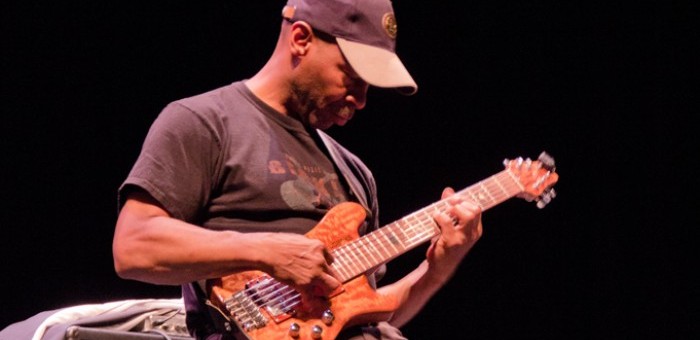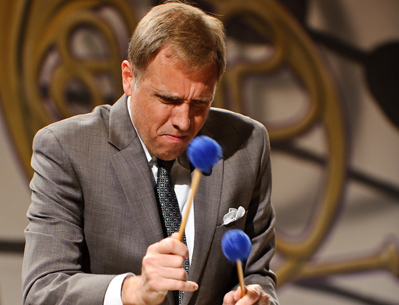Dec 9, 2025 12:28 PM
In Memoriam: Gordon Goodwin, 1954–2025
Gordon Goodwin, an award-winning saxophonist, pianist, bandleader, composer and arranger, died Dec. 8 in Los Angeles.…

Kevin Eubanks performs Aug. 19 at the Wilson Center Guitar Festival in Brookfield, Wisconsin.
(Photo: Julia Crowe)A smooth, scintillating sound emanates from Kevin Eubanks’ recent release, East West Time Line (Mack Avenue). The former Tonight Show guitarist and his bi-coastal bandmates—East Coasters Jeff “Tain” Watts (drums), Dave Holland (bass), Nicholas Payton (trumpet) and Orrin Evans (piano), with West Coasters Rene Camacho (bass), Mino Cinelu (percussion), Bill Pierce (tenor saxophone) and Marvin “Smitty” Smith (drums)—deliver tracks that shimmer with tonal clarity and superb interplay.
DownBeat spent some time with Eubanks onsite at the Wilson Center Guitar Festival in Brookfield, Wisconsin, to learn more about the inspiration behind his new album. Eubanks also provided insights into the value and impact of musical training and revealed his plans for an exciting forthcoming project.
Let’s discuss the genesis of your album East West Time Line. Some would say that jazz styles differ on each coast. How does this album fuse the sounds of where you started, New York, with where you grew musically, Los Angeles?
New York is densely populated and more aggressive, while in Los Angeles, it is more laid back. The climate and terrain of these cities make you respond and behave differently, and as a result, the rhythms and color of these cities naturally get into the music.
What I did was play with musicians on both coasts. After everything was recorded, I ran into a problem with sequencing. Nothing worked. It didn’t flow. To be efficient with mixing, I sequenced according to each coastal group I worked with. When I sequenced it based on grouping tracks according to the same East coast musicians I’d worked with, then it became easy to sequence. It all flowed. And I did the same with the West coast group. However, if I tried to mix the New York tracks with the L.A. tracks, it did not work. I didn’t consciously plan for the record to reflect a trajectory, but it’s exactly what you pointed out. Everything had its natural fit that I was fighting the whole time. I had to back off it and let it be what it was. Then I found the title. It made sense to me afterward.
There’s an easy rapport between you and your bandmates on “Take The Coltrane,” and there is a laconic elegance to “Something About Nothing.” Could you reflect a bit on these tracks?
I was so used to overthinking when making records, and I didn’t want to do that with this one. I wanted to get everyone comfortable with the idea of hanging out instead of rehearsing. We’d go eat, jam and hang out, so that when we recorded, we’d have that relaxed vibe. I didn’t want to do another version of “Take The A Train.” I wanted to infer it and take an organic approach on that track with my East Coast crew, so we didn’t rehearse that track. We recorded when we got to the studio. It was entirely about being in the moment. “Take The Coltrane” is the first time we’ve received airplay on Latin stations. My bass player, Rene Camacho, plays with Pancho Sanchez.
“Something About Nothing” brings a smile to my face because that is what all this is about. I said, “Just be the nothing for once, instead of the something, and see what happens.” We turn nothing into something, as if there is something wrong with being nothing. Be in the moment. If we played a gig on Thursday and we sounded great, and then we played another gig on Friday, the inclination would be to try to replicate what it was we did on Thursday. That never works because we’re not in the moment anymore. It’s a whole different time, a different moment. This song represents a lot to me. We humans give ourselves gold medals for running fast at the Olympics, all while the cheetah runs faster without a coach, just to have lunch. We tend to take all the fun out of things by making them stressful—so much about something—all while a cheetah gets up, and it’s about nothing. And they do it better than we do.
You have served as the Artistic Director of the Jazz In the Classroom Program for The Thelonious Monk Institute of Jazz from 2010—’12 in Los Angeles, and you continue to contribute your teaching skills in many other outstanding programs. What is your take on the current state of music in schools?
Teaching music is a subject that needs to be emphasized more in schools, not marginalized. Strangely, the very thing we ask people to do once they leave school and enter the workplace are all the skills that tend to not get taught when the arts are removed from the school curriculum—working with people, working on your own, listening to people, giving direction, taking direction, showing up on time and being respectful of other people’s time. These are the traits everyone needs in order to become successful in life, and the arts is the only subject in school that provides this kind of learning experience, whether it be a theater group, a district orchestra or a small jazz combo.
My mom has a master’s degree in Music Education. She and I never made a distinction between music education and the rest of it. It is all the same thing because you have to concentrate, prepare and do the work. What music has given me is the ability to go to another part of the world, into another country, and work with others, even though I may not speak their language. What we have in common is music. How many other skills offer that?
Also, you can be 18 or 20 years old and do the same job alongside musicians who are 60 years old. Each musician has something to learn from one another, younger and older both. Not many professions offer this exchange at an equal value.
Do you have any forthcoming projects you would like to mention?
I was on NPR a while back, doing an interview, and one of their last questions was, “What music is on your iPod?” This is when iPods were still a thing. I said I was listening to Miles Davis’ Kind Of Blue. I can always listen to that every night. And I have a whole array of Janis Ian. Later, when I was leaving the studio, the receptionist said to me, “Janis Ian called and left you a message.” Janis was listening to my interview! The note said, “I don’t believe you.” That’s all the note said! She’d left her email, so I wrote her. And that is when we started hanging out. I said, “You don’t believe me? Ask me to name one of your songs!” When I started singing some of them, she said, “Oh my god!” Then we started getting together to play and write.
Bill Prady, who is the producer of The Big Bang Theory, donated a house concert to Janis’ Pearl Foundation—an Evening with Janis at your house. She invited me to perform with her for this event in L.A., which helps fund college scholarships. The vibe was so natural that everyone at the concert said, “You’ve got to create an album.” Of course, I’ve been telling Janis this for two years now!
I started playing her music when I was young and have spent so much time listening to her guitar picking. Hopefully, some really great things will come out of the CD we plan to create together next year. It will be beautiful. DB

Goodwin was one of the most acclaimed, successful and influential jazz musicians of his generation.
Dec 9, 2025 12:28 PM
Gordon Goodwin, an award-winning saxophonist, pianist, bandleader, composer and arranger, died Dec. 8 in Los Angeles.…

Belá Fleck during an interview with Fredrika Whitfield on CNN.
Jan 13, 2026 2:09 PM
The fallout from the renaming of the John F. Kennedy Center for the Performing Arts to include President Donald…

Flea has returned to his first instrument — the trumpet — and assembled a dream band of jazz musicians to record a new album.
Dec 2, 2025 2:01 AM
After a nearly five-decade career as one of his generation’s defining rock bassists, Flea has returned to his first…

Dec 11, 2025 11:00 AM
DownBeat presents a complete list of the 4-, 4½- and 5-star albums from 2025 in one convenient package. It’s a great…

Vibraphonist Chuck Redd found himself in the midst of a political firestorm after canceling his gig Dec. 24 at the newly renamed Trump Kennedy Center.
Jan 6, 2026 2:32 AM
The Board of Trustees at Washington, D.C.’s Kennedy Center for the Performing Arts voted on Dec. 18 to rename the…